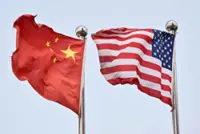US President Donald Trump.
AS during his first term, President Donald Trump is using tariffs as a powerful tool for economic and political leverage to protect the US’ interest by slapping tariffs on imports of goods from major trading partners.
Trump 2.0 is fundamentally different from Trump 1.0.
This time, Trump is better prepared in approaching the tariff policy at a different speed, leveraging it to cut a deal.
The current “blanket tariffs first” approach was absent from 2017-2020.
During Trump 1.0, he started talks with China and signed tariff-related executive orders in the early months of 2017, but then held off on key new duties for an entire year. It wasn’t until Jan 22, 2018, that Trump levied duties on solar panels and washing machines.
He invoked a 1977 law allowing the president to declare an emergency and act immediately to expand tariffs if a country imposes new tariffs on the United States.
On Feb 1, 2025, President Trump issued three executive orders imposing new tariffs – 25% on imports from Mexico and Canada, and 10% on China, each originally slated to go into effect on Feb 4, 2025.
On Feb 3, Trump agreed to pause the tariffs on Canada and Mexico for 30 days, but not for China, which went into effect as planned on Feb 4.
China retaliated with tariffs on a raft of US products, including 15% on coal and liquefied natural gas, and 10% on crude oil and agricultural machinery.
While markets heaved a sigh of relief and welcomed the pause on Canada and Mexico, persistent jitters about the uncertainty surrounding the Trump administration and what comes next will continue to stir volatility in global financial markets.
In the months or year ahead, Trump will continue to use the threat of tariffs to get what he wants from US economic partners.
Trump indicated that the 27-nation European Union (EU) will be his next target for tariffs, without providing details.
Additionally, he will announce reciprocal tariffs that would allow the US to impose tariffs equal to those other countries impose on the US goods, the latest move that could push the United States closer to a wide-scale trade war.
Trump also announced a new 25% tariff on all imports of steel and aluminium into the United States.
The tit-for-tat tariff retaliation between the United States and targeted countries risks igniting a trade war that could significantly dent the economies of both sides.
The tariffs could lead to potentially much higher inputs costs for businesses, increased prices for consumers, disrupted supply chains and the loss of jobs in the affected industries due to reduced product competitiveness and lower demand.
Globally, the trade war escalation will dampen economic growth and trade volume in the short to medium term.
More broadly, the price and income effects, as well as supply chain disruptions, of the tariffs could lead to significant uncertainty for businesses and reduced consumer confidence.
This could ultimately contribute to a decline in consumer spending, especially if businesses pass higher operating costs onto consumers.
During Trump 1.0, global gross domestic product (GDP) slowed to 3% in 2018 and 2.6% in 2019, from 3.3% in 2017, while trade volume also pulled backed significantly from 5.9% in 2017 to 4.3% in 2018 and 1.4% in 2019.
When the Covid-19 pandemic erupted in 2020, global GDP contracted by 3.1%, while trade declined even more sharply by 7.8%, partly due to the trade conflict between the United States-China.
A study on global foreign direct investment (FDI) patterns, using project-level data on announced greenfield investment, indicated that the global number of announced FDI projects declined in 2019, consistent with the onset of new trade tensions. The number fell by 1.3% between 2018 and 2019. In value terms, the decline was 16.5%, particularly in high trade-exposed FDI projects in 2019.
A “counter-retaliation” on trade barriers has immediate and costly implications for all countries, given the deep economic linkages and integration within global value chains. There are valid concerns that the escalating trade war will negatively affect FDI flows.
The trade tensions in 2018-2019, amplified by the Covid-19 pandemic, threatened the profitability of export-oriented investment projects that were widely integrated in global value chains. It accelerated the reconfiguration of global production, suppliers’ networks and supply chains by reshoring, nearshoring, friendshoring, onshoring and offshoring.
While the current trade conflict increases the potential investment returns for “tariff-jumping” projects, in which a company sets up operations in a foreign country to avoid import duties on its products, the Trump’s threat of sweeping “blanket tariffs” on other countries could temper the investment prospects.
What are the threats and opportunities for Malaysia?
The planned 25% tariff on all steel and aluminium imports into the United States, on top of existing duties, will have a small impact on Malaysia as we are not one of the largest exporters of iron and steel items to the United States.
The tariff war will have an indirect impact on Malaysia via the negative investor sentiment concerning the tariff retaliation impact on global growth, trade and investment flows.
Malaysia’s equity and foreign-exchange markets have experienced some weaknesses on dampened sentiment following the tariff announcements, triggering a global selloff in stocks, bonds and industrial commodities.
Malaysia, a small economy that relies on trade openness, remains vulnerable to the risks posed by escalating trade conflict.
These tensions can affect global economic growth, trade flows and the economies of our major trading partners, the United States and China, which are directly impacted by the trade war.
Overall, broader trade frictions will have both direct and indirect impacts on Malaysia via trade, financial and investment channels.
If the Trump administration unilaterally imposes sweeping tariffs on the US imports from China and other trading partners, the direct and indirect effects (via rerouting) on Malaysia’s exports will depend on the substitutability of the affected products, reconfiguration of supply chains and production, transshipment and the cost and price competitiveness of Malaysian firms’ products.
Firstly, we concur with the government’s approach that Malaysia needs to take a free and neutral stance in the tariff war between the United States and its rivals China, Mexico and Canada.
Being a small economy that relies on international trade, Malaysia must continue to adopt liberal trade and investment policies.
Malaysia’s neutral stance leaves possibilities open for trade and investments for investors to consider the country as an alternative investment location, given its strategic sweet spot as part of the investment undertaking and business risk diversification strategy to moderate the impact from the United States’ trade conflict with its trading partners.
Secondly, Malaysia needs to keep tab on Trump’s tariff policy developments and prepare contingency measures to mitigate the impact of potential escalating trade war on domestic manufacturers and exporters via supply chains disruption.
These include providing export credit scheme to domestic small and medium enterprises, reducing import duties on raw materials, assisting in exploring new export markets and diversifying supply chains.
Malaysia’s diversification of products, markets and multiple sources of FDI helps reduce vulnerability to the risks posed by trade tensions on specific sectors, industries and countries.
The government must continue to enhance Malaysia’s position as a competitive manufacturing and services hub through participation in multilateral and bilateral trade agreements.
These include the China-Asean free trade agreement (FTA), the Regional Comprehensive Economic Partnership and the Comprehensive and Progressive Agreement for Trans-Pacific Partnership in efforts to further diversify the country’s supply chains and markets. Additionally, Malaysia’s signing of a Comprehensive Economic Partnership Agree-ment with the United Arab Emirates serve as a conduit to build more trade ties with Middle Eastern countries.
Malaysia’s resumption of FTA negotiations with the EU will also strengthen economic cooperation with the European bloc.
While Malaysia could gain from trade diversion, firm-level rerouting must refrain from using the country as a base to “rebadge” products to circumvent the US tariffs.
This could lead to more punitive tariffs imposed by the United States on Malaysia’s products.
In this regard, the government must stay vigilant and put in place safeguard measures to rein in the potential ramifications from the trade conflicts, especially from parties that may take punitive actions against third parties that serve as routes for tariff evasion.
Under Trump 1.0, the blanket tariffs imposed by the United States on selected products namely steel and aluminium products, solar panels and washing machines did not appear to have a significant impact on Malaysia, except for photovoltaic products in 2018.
Anecdotal evidence indicated that firms affected by the blanket tariffs reported neutral to mildly negative impact.
Thirdly, while Malaysian businesses, manufacturers and exporters gained experience in navigating the trade tensions in 2018-2019, they should consider steps to mitigate the effect of the current tariffs on their business operations.
As part of managing tariff risk, businesses have to understand their potential exposure throughout the whole supply chains, including second- and third-tier suppliers.
They should consider their option, and assess how the tariffs could impact their cost structures and supply chains.
These involve strategies such as diversify sourcing strategies, stock planning, front-loading shipments, logistics planning to avoid delivery delays and revamping supply chains.
Lee Heng Guie is Socio-Economic Research Centre executive director. The views expressed here are the writer’s own.





